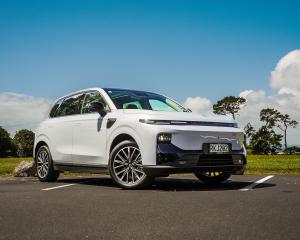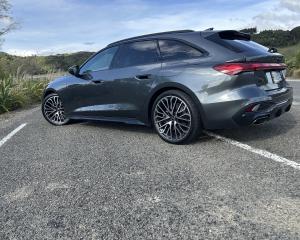
Realisation that the Series II now provisions a feature that perplexed in its absence from the original did not come straight away. I guess because it is such a fundamental.
It was only toward the end of a day that started out sunny then turned to shower did it twig. This car now has a rear wiper.
So hooray for that.
Hooray, also, for other improvements, though save for clearly picking up a new wheel styling, the refreshed model looks just like the same car that has been around for four years.
In driving aptitude, it has changed. Or, more accurately, refined. Updates to the suspension and structural components see to it becoming smoother and less resonant across all surfaces — it’s also less rattled by gravel.
There is also improvement to its refinement; the Ioniq has always been a quiet car, well-insulated from extraneous noises. It also all the moreso now. And it also goes further now thanks to a bigger battery.
All this really should make a difference to how it is considered by electric aficionados, but in this climate, who can really tell? Electric interest at the moment is neither as strong as it once was, nor as strong as it should be.
Personally, I’d suggest those who liked it before will find reason to like it even more, now.
But then, I’ve always held this model in high regard; as the first in the Korean manufacturer’s next generation of electric cars, it really made huge impression.
The prescience of a larger-than-it-looks crossover built on a new dedicated EV platform, with high-voltage battery technology to allow super-fast charging, remains obvious. Almost ahead of its time when new — insofar that the charging infrastructure then wasn’t as useful to it at first as it is now — it still stands tall in a far more complete and complex sector, with cutting-edge technology still uncommon in its class.
Securing the only national motoring award considered wholly without commercial involvement, the New Zealand Car of the Year as decided by the NZ Motoring Writers’ Guild, was a shoo-in.
That was back in 2021, when electric vehicles were very much on a roll. For this car to be the third electric in a row to nab the national title was a strong message about how the market was shifting back then.
The guild’s decision proved prescient. In 2022, this car also scooped big global awards — design of the year, best electric and world car of the year. Sales here took off. The future looked bright. And it was, until ... well, surely you know what’s happened since the end of 2023?

Still, at a time when EV sales now are still only slowly picking up, that they’ve kept commitment to supply the volume-generating "5" in its mid-life facelift format is a plus.
So, now it’s a new chapter. Battery size and ranges all increase, the styling has revised and, yes, prices have been pushed around.
Sense and pragmatism often drive electric car purchasing. With that in mind, the edition on test seems a good consideration, though the price it commands also requires careful thinking.
In the old days, the best buy was that $79,990 rear drive because it got a rebate. However, that version wasn’t the best Ioniq 5. The trim was in keeping with the price and because it had a 58kWh battery, the range wasn’t dramatically good.
That cheapest choice is a stronger position now, with a 63kWh battery, but it still seems logical to aim higher if you can, though not as high as was once the case.
Back when this shape was new, anyone chasing best range from the available choices really had to gravitate to the rear drive Elite, which eked an unsurpassed 481km return from a 72.6kWh battery. The catch? It left just $410 change from a $100k outlay.
Better news, now, for those who prioritise range above all else. The model on test is also single motor rear-drive, it has the same torque and 8kW more power than the previous Elite. But in now feeding off an 84kWh battery, the WLTP-attested driving range stands at 570km, commercial charging is possible at up to 200kW. And the sticker is $10,000 lower.
So what’s the catch? The clue is in the model designation. What’s on test here is an Active, the trim level that sits below that for the Elite. Most obviously, instead of full leather you get wool yarn and eco-processed leather for the seat upholstery. Some other appointments also go by the wayside.
Still, overall, it’s hardly a major downgrade. One strength of Ioniq 5 is that across all its versions, the interior is clean-lined and feels high-quality.
A comment made back when this car entered the market still hold true; namely, if you had never been in a higher grade, you wouldn’t know you were missing out. The Ioniq 5 remains a highly comfortable, fully competent and solidly furnished car.
It is a roomy one, as well. I’d forgotten how difficult it is to comprehend its impressive size until you see one in the metal, glass and plastic. In pictures, the five-door design looks to be a "regular" hatchback, but in reality it’s much larger: wider than a Tucson medium SUV and longer than the previous generation Santa Fe, which was a seven seater.
The Ioniq 5 is still a magnet for a diversity of opinion. Some see it as daring, some not. But it shouldn’t be cursorily dismissed, because it is brimming with interesting details.
But space continues to be a sales pitch, and why not? Thanks to the distance between the front and rear axles and the flat floor, the cabin is an airy zone inside; plenty of area in which to stretch out front and rear and soaring head room, too.

Along with obvious attention to detail and design execution, there’s an air of quality. A three-spoke steering wheel in place of the original two-spoke one makes no difference in practical sense, but it looks smarter. Perhaps because so many other makers have followed suit, the drive selector, a thick stalk on the right, doesn’t confuse me as it used to. Back when this car was fresh, I’d occasionally either mistake it for the indicator wand or twist it the wrong way when seeking Reverse or Drive. Not now.
Boot space is generous, if not quite segment-leading, at 520 litres with the rear seats in place. Additionally, in any version of Ioniq 5, extra boot space can be freed up by sliding the rear seats forward and passengers can also alter the angle of the backrests for comfort. Meanwhile, the rear seat backs fold down to form a flat surface with the main boot floor and an extended 1580-litre capacity.
The parcel shelf is usefully retractable, giving you the opportunity to hide contents. A colleague with kids says it can make installing top tethers for child seats a touch finicky. There is also a handy 57-litre "frunk" storage space under the bonnet for small items.
Setting speed records is clearly not the priority for any of the mainstream Ioniq 5s; that’s very much the job for the N car.
This example reminded me that the everyday model is about imparting a cocoon of calmness. It does this brilliantly. It also has more of a driver-centric feel than before.
With the original car, the steering didn’t provide much feedback and the suspension wasn’t always in tune with surface condition; it was one of those curious cars that had you wishing it was firmer in some circumstances yet softer in others.
This time? Hyundai hasn’t been too specific about the updates to the suspension and structural components, but says changes have been made to improve refinement and driving feel. These changes have done the job, as this updated Ioniq5 feels more driver-connected and more rewarding as result.
As with all current electric cars, you cannot escape that it is heavy, at just under two tonnes. But the majority of its mass is low down between the wheels, and so the Ioniq 5 handles well, with little body lean in corners; it’ll just flow through those so long as you don’t fall into the trap of rushing too hard into them. That’s when you learn how good the brakes are. The N is still the one for absolute fun, but at this level you get a good balance of comfort and fun.
The electric car world has changed a lot since this car was introduced, but all in all, it continues to impress as much as it did when first met. That’s quite an achievement, given the pace of advances by so many involvers. And also its maker.
Seoul is on a real roll; it makes clear that "as good as it gets" is not enough. And yet, this car, the first big effort, still stands in its updated guise as one of its best.
AT A GLANCE
HYUNDAI IONIQ 5 SERIES II
Overall rating: ★★★★★
Design and Styling: ★★★★★

Performance: ★★★★★
Ride and handling: ★★★★★
Safety: ★★★★★*
Environmental: ★★★★★
SPECIFICATIONS
Price: $89,990.
Powertrain: Single electric permanent magnet synchronous motor; maximum power 168kW, maximum torque 350Nm
Transmission; Single speed, rear-wheel-drive.
Safety rating: Five-star ANCAP.
Wheels and tyres: Alloy wheels, 235/55 R19 tyres.
Battery and economy: 84.8kWh (80kWh usable) lithium-ion polymer with water cooling, estimated combined economy (WLTP Combined test) 17.8kWh/100km.
Dimensions: Length, 4635mm; width, 1890mm; height, 1600mm.
Kerb weight: 1985kg.
Road test by Richard Bosselman












